Click on images to enlarge
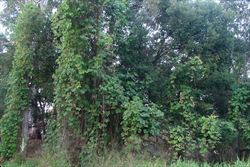
infestation (Photo: Sheldon Navie)
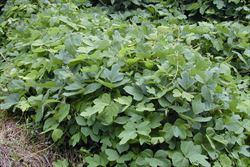
creeping habit (Photo: Forest and Kim Starr, USGS)
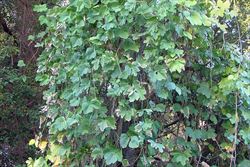
climbing habit (Photo: Sheldon Navie)
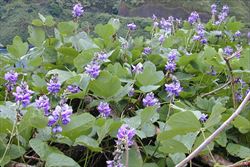
habit in flower (Photo: Forest and Kim Starr, USGS)
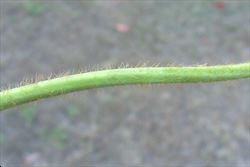
close-up of thick stem covered in brownish-coloured hairs (Photo: Sheldon Navie)
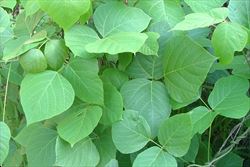
the large leaves with three leaflets (Photo: Sheldon Navie)

leaf with two-lobed side leaflets and three-lobed upper leaflet (Photo: Sheldon Navie)
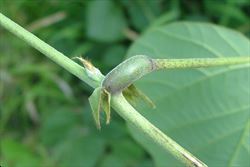
swollen base of leaf stalk (Photo: Sheldon Navie)
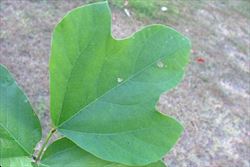
close-up of an upper leaflet with three lobes (Photo: Sheldon Navie)
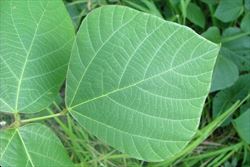
close-up of an upper leaflet without lobes (Photo: Sheldon Navie)

close-up of a side leaflet with two lobes (Photo: Sheldon Navie)
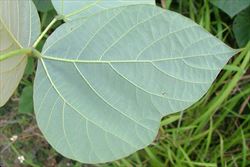
close-up of the paler underside of a leaflet (Photo: Sheldon Navie)
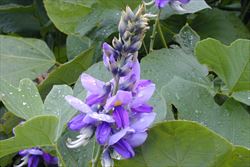
elongated flower cluster (Photo: Forest and Kim Starr, USGS)
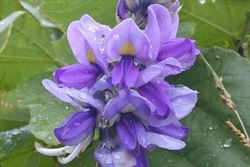
close-up of peas-shaped flowers with yellow of white markings (Photo: Forest and Kim Starr, USGS)
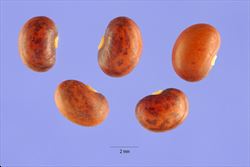
Scientific Name
Pueraria montana (Lour.) Merr. var. lobata (Willd.) Maesen & S.M. Almeida
Synonyms
Dolichos lobatus Willd.Pueraria lobata (Willd.) Ohwi
Family
Fabaceae (Queensland, the ACT, Victoria, Tasmania, and the Northern Territory)Fabaceae: sub-family Faboideae (New South Wales)Leguminosae (South Australia)Papilionaceae (Western Australia)
Common Names
Japanese arrowroot, kudsu, kudzu, kudzu vine
Origin
Native to temperate north-eastern Asia (i.e. far-eastern Russia, Japan, Korea and Taiwan) and tropical south-eastern Asia (i.e. Thailand, Vietnam, Indonesia, Malaysia, Papua New Guinea and the Philippines). Probably also native to, or an early introduction to, some western Pacific islands (i.e. Fiji, New Caledonia, the Solomon Islands and Vanuatu).
It is also present in the coastal districts of north-eastern Northern Territory, and is regarded as being native to this area.
Cultivation
Kudzu (Pueraria montana var. lobata ) was deliberately introduced into Australia many years ago as a potential forage legume. Overseas it has been cultivated for its edible root.
Naturalised Distribution
Kudzu (Pueraria montana var. lobata) is scattered in the coastal districts of eastern Australia. It is naturalised in northern, central and south-eastern Queensland and in the coastal districts of northern and central New South Wales. It is also naturalised on Norfolk Island.
Naturalised overseas in the USA, Mexico, Central America (i.e. Panama), eastern Europe (i.e. Ukraine), western and central Asia, southern Africa and on some Pacific islands (i.e. Hawaii, American Samoa, Western Samoa, French Polynesia and Tonga).
Habitat
A weed of riparian vegetation, moist forests, watercourses, roadsides, waste areas and disturbed sites in warmer temperate, sub-tropical and tropical regions.
Habit
A large twining or creeping long-lived (i.e. perennial) vine with stems up to 10 m long which can quickly envelope trees or spread rapidly across the ground. Its thickened roots develop into large tubers (up to 1.8 m long and 15 cm wide).
Distinguishing Features
- a large twining or creeping vine with relatively thick stems covered with long yellowish-brown hairs.
- its thickened roots develop into large tubers (up to 1.8 m long and 15 cm wide).
- its very large alternately arranged leaves have three lobed or un-lobed leaflets (7-20 cm long and 5-13 cm wide).
- its pea-shaped flowers (12-20 mm long) are arranged in elongated clusters in the leaf forks.
- these flowers are either purple, blue, pink or violet in colour with a yellow spot near their centres.
- its fruit is an elongated and flattened pod (5-12 cm long) that is densely covered in rusty-coloured hairs.
Stems and Leaves
Its rampant stems are relatively thick and covered with long, appressed to spreading, yellowish-brown hairs.
The very large alternately arranged leaves are compound with three leaflets (i.e. they are trifoliate) and borne on stalks (i.e. petioles) 8-13 cm long. At the base of each leaf stalk there is a pair of small leafy structures (i.e. stipules) 8-16 mm long. Each of the large leaflets (7-20 cm long and 5-13 cm wide) may be un-lobed or slightly lobed and usually has pointed tips (i.e. acuminate apices). The uppermost (i.e. terminal) leaflet is usually slightly larger and three-lobed, while the two side (i.e. lateral) leaflets usually have two lobes. Some or all of these leaves may be shed during cooler and/or drier conditions (i.e. it is deciduous). Both sides of the leaflets are sparsely hairy (i.e. pubescent). The upper surfaces are light green while the undersides are grayish-green.
Flowers and Fruit
The pea-shaped flowers are produced during summer and are borne in elongated clusters (15-40 cm long) in the upper leaf forks (i.e. in axillary racemes). These clusters contain up to 90 purple, blue, pink or violet-coloured flowers (12-20 mm long). The flowers have five sepals (6-12 mm long), that are fused together at the base, and five petals. The uppermost petal (i.e. standard) is larger that the two side petals (i.e. wings) and has a yellow spot near its base. The two lower petals are fused together and folded (i.e. into a keel). The flowers also have ten stamens, nine of which are fused together with the other being separate from the rest, and an ovary topped with a style and stigma.
The fruit is an elongated and flattened pod (5-12 cm long and about 12 mm wide) that is densely covered in rusty spreading hairs. These pods contains several (8-12) seeds.
Reproduction and Dispersal
Kudzu (Pueraria montana var. lobata) reproduces mainly vegetatively by runners (i.e. stolons) and creeping underground stems (i.e. rhizomes). It occasionally also reproduces by seed.
The seeds can be dispersed in water and contaminated soil, while the stem segments and rhizomes can be spread in dumped garden waste and contaminated soil.
Environmental Impact
Kudzu (Pueraria montana var. lobata) is regarded as an environmental weed in Queensland and New South Wales. It is also listed as a priority environmental weed in at least one Natural Resource Management region.
Legislation
This species is declared under legislation in the following states and territories:
- New South Wales: Class 3 - a regionally controlled weed. The relevant local control authority must be promptly notified of the presence of this weed and it must be fully and continuously suppressed and destroyed (in the Ballina, Bellingen, Byron, Clarence Valley, Coffs Harbour, Kyogle, Lismore, Nambucca, Richmond Valley and Tweed local authority areas).
- Queensland: Class 2 - landowners must take all reasonable steps to keep land free of this species (throughout the entire state, except the Torres Strait Islands). It is also illegal to sell a declared plant or its seed in this state.
- Western Australia: Prohibited - on the prohibited species list and not permitted entry into the state.
Similar Species
Kudzu (Pueraria montana var. lobata) is very similar to tropical kudzu (Pueraria phaseoloides), but these two species can be differentiated fron each other by the following differences:
- kudzu (Pueraria montana var. lobata) produces large underground tubers up to 1.8 m long and 15 cm wide and its fruit are relatively wide (about 12 mm across).
- tropical kudzu (Pueraria phaseoloides) does not produce any underground tubers and its fruit are relatively narrow (about 5 mm across).

